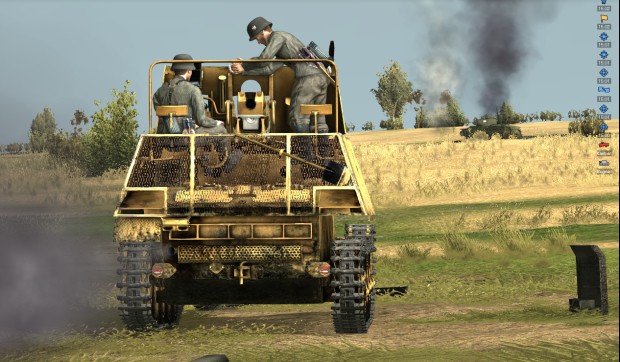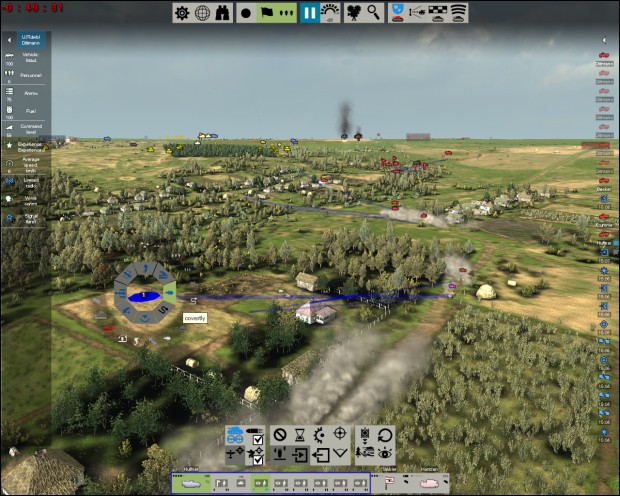The Flare Path: Things You Need To Know About Graviteam Tactics: Mius Front
Embracing the chaos
...ahead of its release tomorrow.
1. It will ship with major realism flaws. Having spent a couple of days with the latest build of this painfully overdue Operation Star sequel, I'm now in a position to say with certainty that the Ukrainian devs have made no effort whatsoever to model incidental lubrication. Route a Tiger tank through a field of sunflowers and the Panzerkampfwagen VI will be squeaking just as loudly when it exits the field as when it enters it. Poor show, Graviteam. Poor show.
2. The choice of setting may leave you slightly disappointed. Graviteam's Eastern Front obsession is completely natural, and guarantees realistic maps, authentic soldier expletives, and authoritative orders of battle but does risk alienating wargamers a little weary of rolling hills, thatched dachas, and endless T-34s. Watching Lend Lease tanks like the Stuart, Valentine and Matilda doing their thing I can't help wishing the third/fourth instalment in this realism-heavy real-time* wargame series was subtitled Gazala or Kasserine Pass.
*Orders can be issued while paused. The strat layer is turnbased
And looking on as waves of Soviet infantry surge towards my trenchlines, I can't help picturing Graviteam Tactics: Gaza-Beersheba.
3. Anticipate a little confusion in your first week. Tuition and documentation really aren't Graviteam's forte, and the reworked GUI is arguably just as elaborate/idiosyncratic as the old one. While newcomers should, with the help of a malnourished manual and a handful of tutorials, be able to grasp the basics of moving and fighting within an hour or two, elements of the campaign system and new tactical complexities like comms and command points could confound for days if not weeks. After around sixteen hours of campaigning I'm still a bit baffled by the artillery plotting system, the mechanics of reinforcing depleted platoons between battles, and the best way of using my little teams of battlefield telephone engineers. Roll on the launch and the inevitable flurry of 'How do I...' forum threads.
4. GT's physics remain amazing. Graviteam started out making AFV sims, and that respect for mass and momentum has seeped into their wargames with mesmerising results. Tank deaths in Mius Front frequently warrant a few turns of the mousewheel. For every two or three landships that perish demurely, there's usually one that hams it up outrageously, trundling on out of control after its crew have baled or died at their posts. Some haemorrhage blazing fuel during these terminal rambles. Some burn merrily after coming to rest, shaking their surroundings with secondary explosions long after the battle has moved on. A few even fake their own deaths, sitting quiet as tombs until the crews that abandoned them in panic summon up the courage to return.
Direct a heavyweight up a steep slope, or across a frail bridge or yawning anti-tank ditch, and the wonderful physics can change the whole course of a scrap. After a lazily plotted advance over difficult terrain, it's not uncommon to find that you've got a missing AFV. Retracing the route you eventually locate the absentee writhing in a steep-sided gully or nose down in a trench. Sometimes a reverse order, direction change, or deft nudge from another vehicle will save the day. On other occasions, no amount of industry and ingenuity will rectify the situation.
5. GT's ballistics still impress too. It's impossible to hurry on to the next engagement in a campaign without first taking advantage of the 'tour battlefield' option. After a battle the multicoloured impact labels that fur the hulks of vehicles and guns like extraterrestrial hyphae, tell dramatic stories of survival, luck and loss. Ah, so it was an unspotted 45mm AT gun that eventually slew my last halftrack and it was my immobilised StuG not my Tiger that finally nailed that troublesome KV-1.
6. Very, very, few wargames offer a superior campaign experience. Dwarfing its friendly custom battle builder and random scrap generator (both of which utilize portions of the same seamless 140 square kilometre tract of Donets Basin terrain) the way a King Tiger dwarfs a Kettenrad, Mius Front's campaign mode offers two sizeable summer 1943 operations each completely dynamic and playable as either the Germans or Soviets. Where other wargame studios rely on the skill of their scenario smiths to generate excitement and challenge, Graviteam rely wholly on an AI intent on seizing/holding strat-map Victory Locations and maintaining a viable front line.
Manoeuvres on the strat map generate complex tactical battles of delicious unpredictability and variety. Counter-attacks arrive from unexpected directions; villages change hands multiple times during the course of an op; the urge to push forward is constantly checked by the impulse to rest, protect flanks, and prevent pocketing. I adore Graviteam's approach to campaigning even if I don't currently fully understand all the new subtleties they've introduced in this instalment.
7. AI assaults feel more organised now. Yes, you'll still see the CPU mounting frontal infantry attacks across open ground when an oblique forest-shrouded route might be more sensible but chances are he'll be attempting to screen his push with lashings of smoke and support it with heavy weapons. He also seems less willing to send armour into areas where armour is vulnerable – trench networks, contested village interiors and the like.
Last night I waited for a logical counter-attack that never came and watched a few soldiers flee in a silly direction, but in the jaw-dropping maelstrom of a large-scale Mius Front engagement, behavioural oddities like these are very easy to overlook.
8. At times Graviteam Tactics: Mius Front will leave you speechless. There will be moments - I guarantee it - when the fury of battle will cause you to abandon high-altitude order issuing for a spell and WASD-wander the corpse- and hulk-strewn killing fields gawping at the unfolding human dramas all around. Other wargames recreate the patterns and tactical challenges of WW2 engagements superbly, but GT Mius Front also captures something of the spectacle, emotion, and madness of combat.
One of my most recent scraps involved an assault on a German-held hill necklaced by AT ditches and infantry trenches. The assault began in tracer-stitched darkness (night battles are optional but deactivate them and you miss out on some memorable clashes) and ended an unforgettable hour later in the pale light of early dawn. Drifts of blood-badged khaki corpses marked the avenues of my multi-pronged advance. A string of knocked-out KV-1s and Stuarts chronicled the struggle I'd had neutralising a pair of cunningly sited and carefully dug-in StuGs. I had my hill but my sense of triumph was mingled with trepidation (withstanding subsequent counterattacks would be tricky) and tinged with guilt.
* * * * *












